Junbo Zhang
JoyAgent-JDGenie: Technical Report on the GAIA
Oct 01, 2025Abstract:Large Language Models are increasingly deployed as autonomous agents for complex real-world tasks, yet existing systems often focus on isolated improvements without a unifying design for robustness and adaptability. We propose a generalist agent architecture that integrates three core components: a collective multi-agent framework combining planning and execution agents with critic model voting, a hierarchical memory system spanning working, semantic, and procedural layers, and a refined tool suite for search, code execution, and multimodal parsing. Evaluated on a comprehensive benchmark, our framework consistently outperforms open-source baselines and approaches the performance of proprietary systems. These results demonstrate the importance of system-level integration and highlight a path toward scalable, resilient, and adaptive AI assistants capable of operating across diverse domains and tasks.
MiDashengLM: Efficient Audio Understanding with General Audio Captions
Aug 06, 2025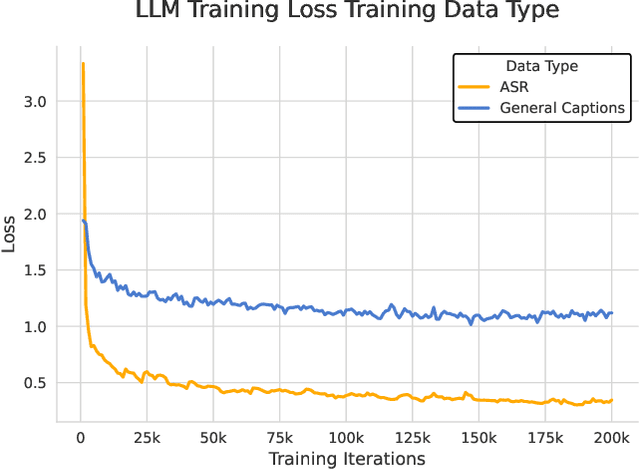
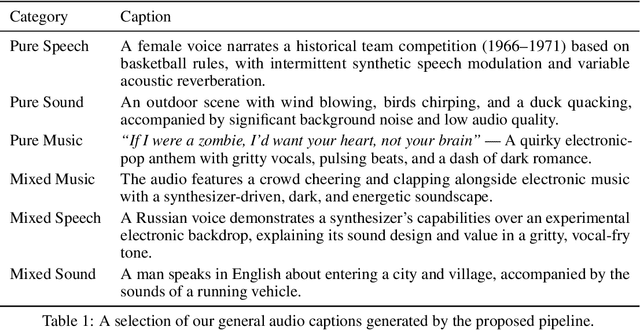
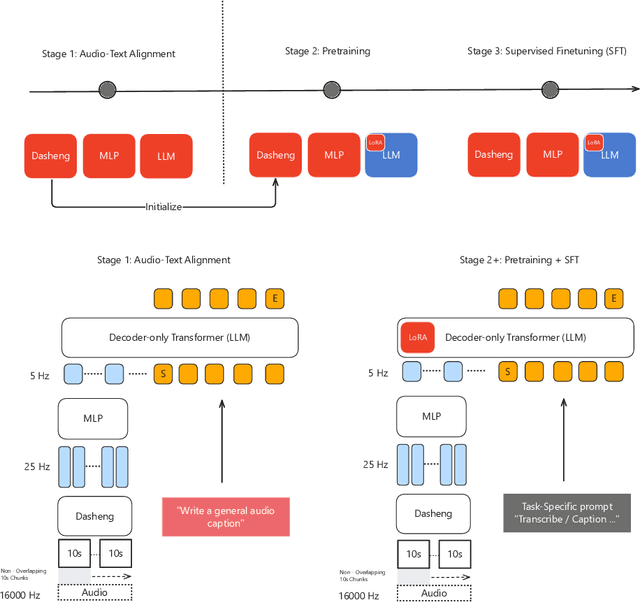
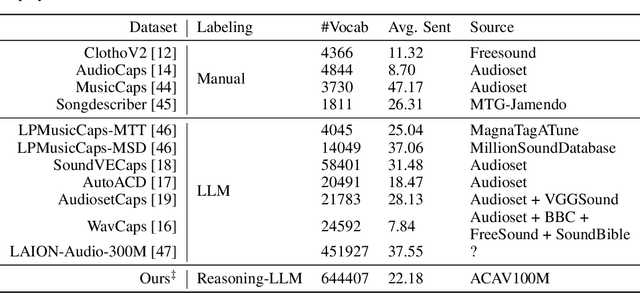
Abstract:Current approaches for large audio language models (LALMs) often rely on closed data sources or proprietary models, limiting their generalization and accessibility. This paper introduces MiDashengLM, a novel open audio-language model designed for efficient and comprehensive audio understanding through the use of general audio captions using our novel ACAVCaps training dataset. MiDashengLM exclusively relies on publicly available pretraining and supervised fine-tuning (SFT) datasets, ensuring full transparency and reproducibility. At its core, MiDashengLM integrates Dasheng, an open-source audio encoder, specifically engineered to process diverse auditory information effectively. Unlike previous works primarily focused on Automatic Speech Recognition (ASR) based audio-text alignment, our strategy centers on general audio captions, fusing speech, sound and music information into one textual representation, enabling a holistic textual representation of complex audio scenes. Lastly, MiDashengLM provides an up to 4x speedup in terms of time-to-first-token (TTFT) and up to 20x higher throughput than comparable models. Checkpoints are available online at https://huggingface.co/mispeech/midashenglm-7b and https://github.com/xiaomi-research/dasheng-lm.
Unified Vision-Language-Action Model
Jun 24, 2025



Abstract:Vision-language-action models (VLAs) have garnered significant attention for their potential in advancing robotic manipulation. However, previous approaches predominantly rely on the general comprehension capabilities of vision-language models (VLMs) to generate action signals, often overlooking the rich temporal and causal structure embedded in visual observations. In this paper, we present UniVLA, a unified and native multimodal VLA model that autoregressively models vision, language, and action signals as discrete token sequences. This formulation enables flexible multimodal tasks learning, particularly from large-scale video data. By incorporating world modeling during post-training, UniVLA captures causal dynamics from videos, facilitating effective transfer to downstream policy learning--especially for long-horizon tasks. Our approach sets new state-of-the-art results across several widely used simulation benchmarks, including CALVIN, LIBERO, and Simplenv-Bridge, significantly surpassing previous methods. For example, UniVLA achieves 95.5% average success rate on LIBERO benchmark, surpassing pi0-FAST's 85.5%. We further demonstrate its broad applicability on real-world ALOHA manipulation and autonomous driving.
Efficient Speech Enhancement via Embeddings from Pre-trained Generative Audioencoders
Jun 13, 2025Abstract:Recent research has delved into speech enhancement (SE) approaches that leverage audio embeddings from pre-trained models, diverging from time-frequency masking or signal prediction techniques. This paper introduces an efficient and extensible SE method. Our approach involves initially extracting audio embeddings from noisy speech using a pre-trained audioencoder, which are then denoised by a compact encoder network. Subsequently, a vocoder synthesizes the clean speech from denoised embeddings. An ablation study substantiates the parameter efficiency of the denoise encoder with a pre-trained audioencoder and vocoder. Experimental results on both speech enhancement and speaker fidelity demonstrate that our generative audioencoder-based SE system outperforms models utilizing discriminative audioencoders. Furthermore, subjective listening tests validate that our proposed system surpasses an existing state-of-the-art SE model in terms of perceptual quality.
GLAP: General contrastive audio-text pretraining across domains and languages
Jun 12, 2025Abstract:Contrastive Language Audio Pretraining (CLAP) is a widely-used method to bridge the gap between audio and text domains. Current CLAP methods enable sound and music retrieval in English, ignoring multilingual spoken content. To address this, we introduce general language audio pretraining (GLAP), which expands CLAP with multilingual and multi-domain abilities. GLAP demonstrates its versatility by achieving competitive performance on standard audio-text retrieval benchmarks like Clotho and AudioCaps, while significantly surpassing existing methods in speech retrieval and classification tasks. Additionally, GLAP achieves strong results on widely used sound-event zero-shot benchmarks, while simultaneously outperforming previous methods on speech content benchmarks. Further keyword spotting evaluations across 50 languages emphasize GLAP's advanced multilingual capabilities. Finally, multilingual sound and music understanding is evaluated across four languages. Checkpoints and Source: https://github.com/xiaomi-research/dasheng-glap.
X-ARES: A Comprehensive Framework for Assessing Audio Encoder Performance
May 22, 2025Abstract:We introduces X-ARES (eXtensive Audio Representation and Evaluation Suite), a novel open-source benchmark designed to systematically assess audio encoder performance across diverse domains. By encompassing tasks spanning speech, environmental sounds, and music, X-ARES provides two evaluation approaches for evaluating audio representations: linear fine-tuning and unparameterized evaluation. The framework includes 22 distinct tasks that cover essential aspects of audio processing, from speech recognition and emotion detection to sound event classification and music genre identification. Our extensive evaluation of state-of-the-art audio encoders reveals significant performance variations across different tasks and domains, highlighting the complexity of general audio representation learning.
Reinforcement Learning Outperforms Supervised Fine-Tuning: A Case Study on Audio Question Answering
Mar 17, 2025
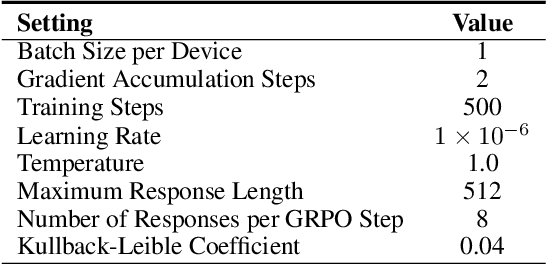

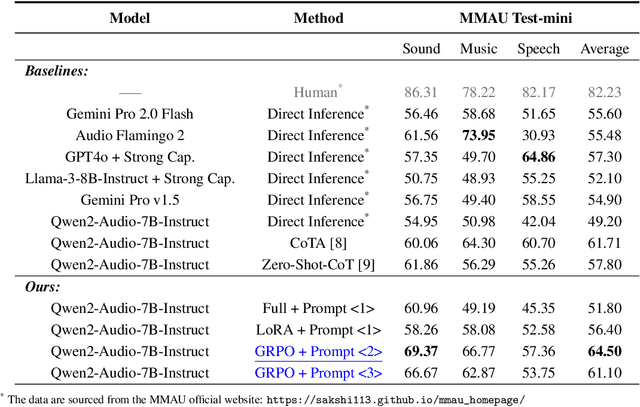
Abstract:Recently, reinforcement learning (RL) has been shown to greatly enhance the reasoning capabilities of large language models (LLMs), and RL-based approaches have been progressively applied to visual multimodal tasks. However, the audio modality has largely been overlooked in these developments. Thus, we conduct a series of RL explorations in audio understanding and reasoning, specifically focusing on the audio question answering (AQA) task. We leverage the group relative policy optimization (GRPO) algorithm to Qwen2-Audio-7B-Instruct, and our experiments demonstrated state-of-the-art performance on the MMAU Test-mini benchmark, achieving an accuracy rate of 64.5%. The main findings in this technical report are as follows: 1) The GRPO algorithm can be effectively applied to large audio language models (LALMs), even when the model has only 8.2B parameters; 2) With only 38k post-training samples, RL significantly outperforms supervised fine-tuning (SFT), indicating that RL-based approaches can be effective without large datasets; 3) The explicit reasoning process has not shown significant benefits for AQA tasks, and how to efficiently utilize deep thinking remains an open question for further research; 4) LALMs still lag far behind humans auditory-language reasoning, suggesting that the RL-based approaches warrant further exploration. Our project is available at https://github.com/xiaomi-research/r1-aqa and https://huggingface.co/mispeech/r1-aqa.
Improving Open-world Continual Learning under the Constraints of Scarce Labeled Data
Feb 28, 2025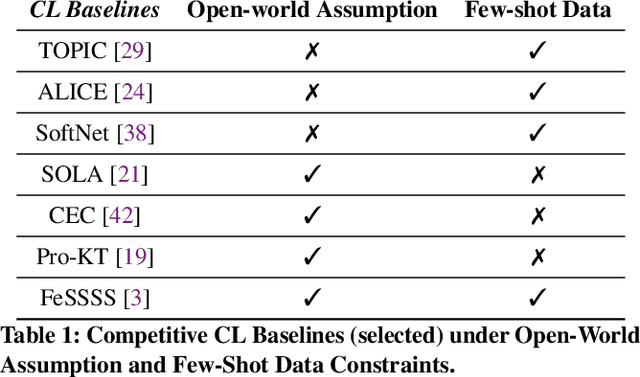
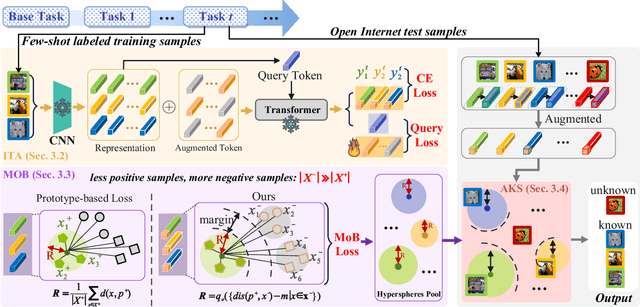
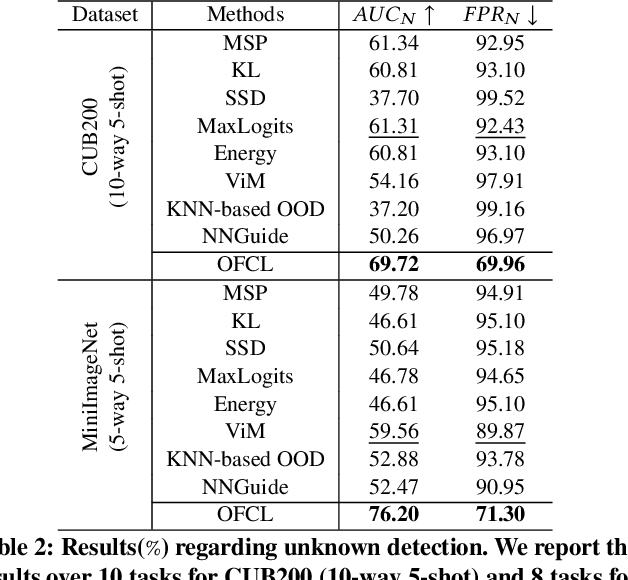
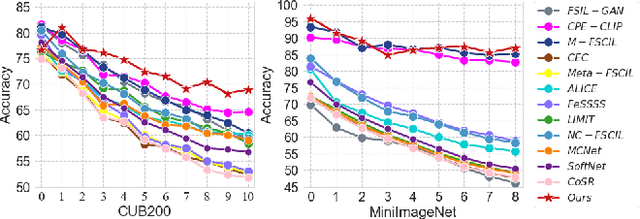
Abstract:Open-world continual learning (OWCL) adapts to sequential tasks with open samples, learning knowledge incrementally while preventing forgetting. However, existing OWCL still requires a large amount of labeled data for training, which is often impractical in real-world applications. Given that new categories/entities typically come with limited annotations and are in small quantities, a more realistic situation is OWCL with scarce labeled data, i.e., few-shot training samples. Hence, this paper investigates the problem of open-world few-shot continual learning (OFCL), challenging in (i) learning unbounded tasks without forgetting previous knowledge and avoiding overfitting, (ii) constructing compact decision boundaries for open detection with limited labeled data, and (iii) transferring knowledge about knowns and unknowns and even update the unknowns to knowns once the labels of open samples are learned. In response, we propose a novel OFCL framework that integrates three key components: (1) an instance-wise token augmentation (ITA) that represents and enriches sample representations with additional knowledge, (2) a margin-based open boundary (MOB) that supports open detection with new tasks emerge over time, and (3) an adaptive knowledge space (AKS) that endows unknowns with knowledge for the updating from unknowns to knowns. Finally, extensive experiments show the proposed OFCL framework outperforms all baselines remarkably with practical importance and reproducibility. The source code is released at https://github.com/liyj1201/OFCL.
Order-Robust Class Incremental Learning: Graph-Driven Dynamic Similarity Grouping
Feb 27, 2025Abstract:Class Incremental Learning (CIL) requires a model to continuously learn new classes without forgetting previously learned ones. While recent studies have significantly alleviated the problem of catastrophic forgetting (CF), more and more research reveals that the order in which classes appear have significant influences on CIL models. Specifically, prioritizing the learning of classes with lower similarity will enhance the model's generalization performance and its ability to mitigate forgetting. Hence, it is imperative to develop an order-robust class incremental learning model that maintains stable performance even when faced with varying levels of class similarity in different orders. In response, we first provide additional theoretical analysis, which reveals that when the similarity among a group of classes is lower, the model demonstrates increased robustness to the class order. Then, we introduce a novel \textbf{G}raph-\textbf{D}riven \textbf{D}ynamic \textbf{S}imilarity \textbf{G}rouping (\textbf{GDDSG}) method, which leverages a graph coloring algorithm for class-based similarity grouping. The proposed approach trains independent CIL models for each group of classes, ultimately combining these models to facilitate joint prediction. Experimental results demonstrate that our method effectively addresses the issue of class order sensitivity while achieving optimal performance in both model accuracy and anti-forgetting capability. Our code is available at https://github.com/AIGNLAI/GDDSG.
The ICME 2025 Audio Encoder Capability Challenge
Jan 25, 2025Abstract:This challenge aims to evaluate the capabilities of audio encoders, especially in the context of multi-task learning and real-world applications. Participants are invited to submit pre-trained audio encoders that map raw waveforms to continuous embeddings. These encoders will be tested across diverse tasks including speech, environmental sounds, and music, with a focus on real-world usability. The challenge features two tracks: Track A for parameterized evaluation, and Track B for parameter-free evaluation. This challenge provides a platform for evaluating and advancing the state-of-the-art in audio encoder design.
 Add to Chrome
Add to Chrome Add to Firefox
Add to Firefox Add to Edge
Add to Edge